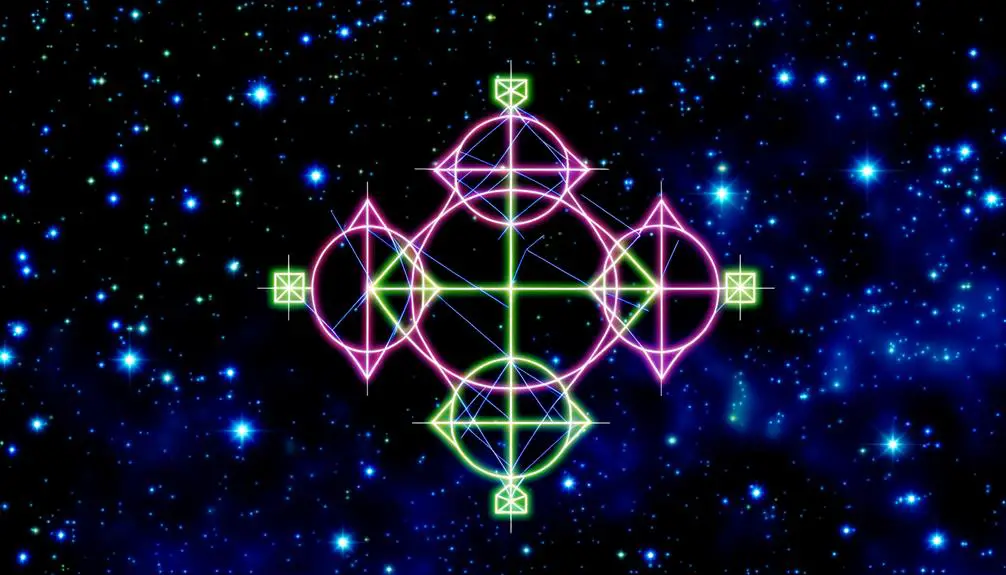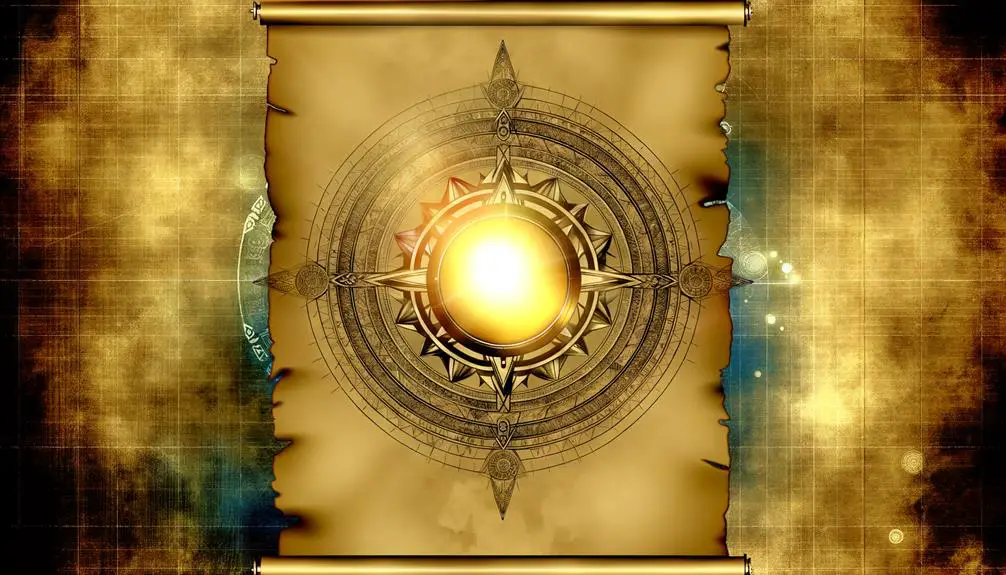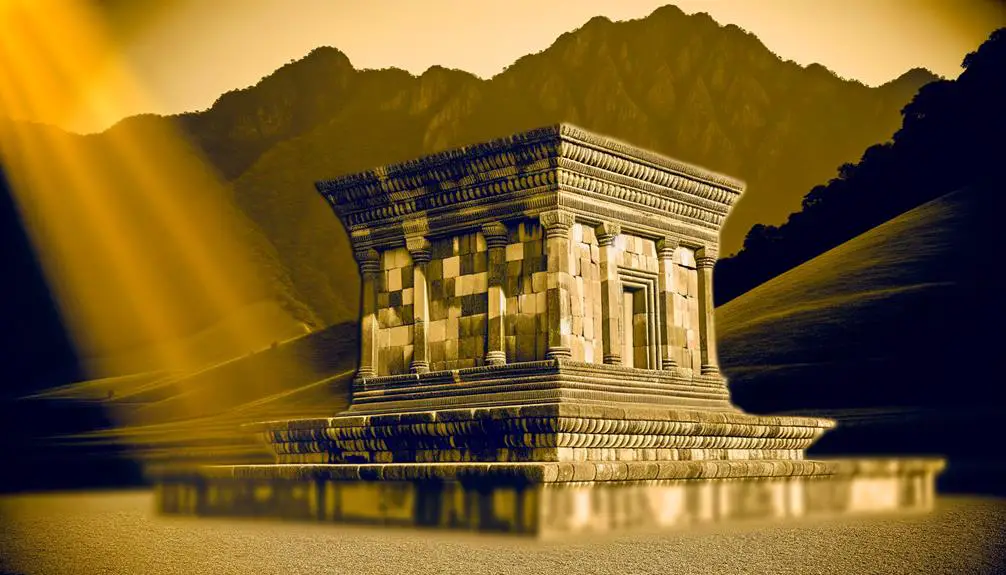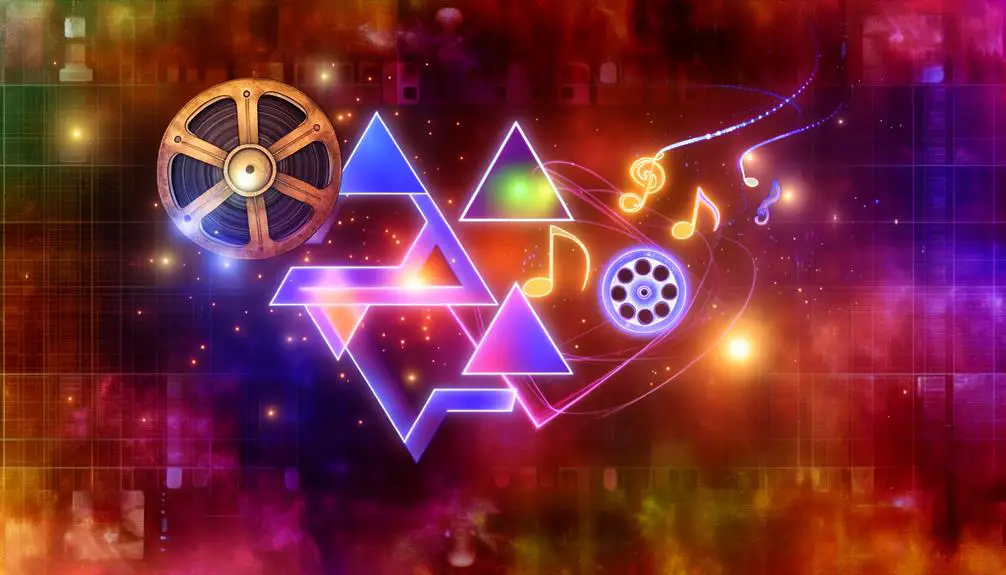What Is the Cultural Meaning of Triangle Circle Cross Square Symbols?
Symbols like the triangle, circle, cross, and square have profound meanings across various cultures. The triangle often denotes a trinity or balance between mind, body, and spirit, as seen in Hindu and Egyptian traditions.
The circle represents eternity, unity, and the cyclical nature of existence, commonly linked to the sun and moon. The cross signifies the intersection of opposites and balance, carrying significant religious connotations.
The square symbolizes order, rationality, and material stability. These shapes are rich with historical and cultural depth, embodying complex philosophies and beliefs.
Exploring their contexts further reveals even more intricate layers of meaning.

Key Takeaways
- The triangle symbolizes balance between mind, body, and spirit, and holds spiritual and mystical significance.
- The circle represents eternity, unity, and the cyclical nature of existence, embodying deep metaphysical implications.
- The cross signifies intersection, balance, and the meeting of opposites, often used to represent conflict and harmony.
- The square denotes order, rationality, and materiality, symbolizing stability and structure.
- Geometric shapes like triangles, circles, crosses, and squares serve as cultural shorthand for symbolic meanings in pop culture and design.
Triangle in Ancient Cultures

The triangle, an elemental geometric shape, held profound symbolic significance in ancient cultures, often representing concepts such as harmony, ascension, and the interplay of the physical and spiritual spheres.
In Ancient Egypt, the triangle symbolized the trinity of gods—Osiris, Isis, and Horus—encapsulating creation, protection, and regeneration.
The Greeks associated it with the Delta symbol, denoting change and the balance of opposites.
Similarly, in Hinduism, the upward-pointing triangle represents Shiva, the god of destruction and transformation, signifying dynamic energy and the male principle.
In contrast, the downward-pointing triangle symbolizes Shakti, the female principle, and fertility.
These interpretations underscore the triangle's versatility as a symbol, reflecting the ancients' nuanced understanding of life's interconnected forces.
Triangle in Modern Symbolism
In modern symbolism, the triangle continues to hold profound spiritual and mystical significance, often representing concepts such as balance, enlightenment, and the trinity in various belief systems.
Its influence extends into contemporary architecture, where its structural integrity and aesthetic appeal are leveraged to create visually striking and stable designs.
Additionally, the triangle frequently appears in pop culture, from logos and fashion to film and music, underscoring its enduring relevance and versatility.
Spiritual and Mystical Significance
Within modern symbolism, the triangle frequently represents the harmonious balance between mind, body, and spirit, reflecting its deep-rooted associations with spiritual and mystical traditions. This geometric shape is often viewed as a bridge between the earthly and the divine, resonating with the concept of ascension and enlightenment.
Triangles appear in numerous spiritual contexts, from the trinity in Christianity to the pyramids in ancient Egypt, symbolizing stability and strength. In esoteric teachings, the upward-pointing triangle denotes male energy and fire, while the downward-pointing triangle signifies female energy and water. Together, they embody unity and wholeness.
Therefore, the triangle's spiritual significance lies in its encapsulation of duality and balance, serving as a profound emblem in modern symbolic language.
Architectural Influence Today
Building upon the triangle's profound spiritual and mystical significance, its influence is prominently evident in contemporary architecture, where it is employed to convey stability, strength, and a harmonious aesthetic. Triangular forms are frequently utilized in structural design, from iconic skyscrapers to minimalist residential spaces, symbolizing innovation and resilience.
| Architectural Element | Symbolic Meaning |
|---|---|
| Skyscrapers | Ambition and Modernity |
| Roof Gables | Shelter and Tradition |
| Structural Beams | Strength and Support |
The triangle's geometric properties provide both visual appeal and functional benefits, ensuring structural integrity and efficient load distribution. This multifaceted application underscores its enduring relevance, as architects continue to draw from its rich symbolic heritage while crafting designs that meet contemporary demands for sustainability and beauty.
Pop Culture References
Although rooted in ancient traditions, the triangle's symbolic resonance has smoothly evolved into modern pop culture. It frequently appears in various media to signify concepts such as harmony, enlightenment, and power. This geometric shape is often employed to evoke a sense of balance and mysticism, making it a versatile and impactful symbol.
- Music and Fashion: Artists like Beyoncé and Jay-Z use triangular motifs to symbolize authority and allure.
- Film and Television: The triangle appears in various narratives, such as the 'Deathly Hallows' in Harry Potter, symbolizing eternity.
- Gaming: In 'The Legend of Zelda,' the Triforce represents bravery, intelligence, and strength.
- Branding: Companies like Google and Adidas incorporate triangles to communicate creativity and reliability.
The triangle's adaptability guarantees its enduring presence in contemporary symbolism.
Circle in Ancient Traditions

In ancient traditions, the circle has emerged as a profound geometric symbol, representing the cyclical nature of time and the universe's wholeness.
Frequently linked to the sun and moon, its unbroken form embodies concepts of eternity and the perpetual cycles of life.
Across various cultures, the circle has been revered not only for its aesthetic simplicity but also for its deep metaphysical implications, symbolizing unity and completeness.
Sacred Geometric Symbolism
Frequently revered across various ancient cultures, the circle is a profound symbol embodying concepts of eternity, unity, and the cyclical nature of existence. Its geometric perfection has been pivotal in numerous traditions, resonating deeply within spiritual and philosophical contexts.
- Eternity: The circle's endless form signifies the infinite nature of the universe and life, transcending time and space.
- Unity: A circle symbolizes wholeness and interconnectedness, reflecting the idea that all elements of the cosmos are interlinked.
- Cycles: Representing the natural cycles of life, death, and rebirth, the circle mirrors the perpetual rhythms of nature.
- Protection: In many ancient cultures, circles were used in rituals and architecture to create sacred spaces, offering spiritual safeguarding.
These elements underscore the circle's enduring significance.
Sun and Moon Representations
Ancient civilizations often imbued the circle with profound symbolism, seeing it as a representation of both the sun and the moon, embodying the dualities of light and darkness, life and death, and the cyclical passage of time.
In many cultures, the sun was depicted as a radiant circle, symbolizing vitality, energy, and divine power. Conversely, the moon, also represented by a circle, signified mystery, intuition, and the natural rhythms of life.
The Egyptians, for example, revered the solar disk as the god Ra, while the moon was associated with Thoth, the deity of wisdom. Similarly, in ancient Chinese philosophy, the circle encapsulated the harmonious balance of yin and yang, reflecting the integral roles of the sun and moon in cosmic equilibrium.
Cycles and Wholeness Concepts
The circle's enduring symbolism in ancient traditions often encapsulates the concepts of cycles and wholeness, reflecting humanity's profound understanding of the interconnectedness of life and the universe. This geometric form, devoid of beginning or end, resonates deeply in various cultures, illustrating the eternal flow of time and existence.
Its significance is manifold:
- Ancient Egyptian Culture: Depicted the sun as a circle, symbolizing Ra, the god of creation and life.
- Hinduism: The mandala represents the universe, embodying cosmic order and spiritual enlightenment.
- Native American Traditions: The Medicine Wheel signifies harmony and the cyclical nature of life.
- Chinese Philosophy: The Taoist yin-yang symbol illustrates balance, duality, and the cyclical nature of opposing forces.
These diverse interpretations underscore the circle's universal role in conveying profound spiritual and philosophical truths.
Circle in Contemporary Society
In contemporary society, the circle frequently symbolizes unity, wholeness, and the cyclical nature of time and existence, permeating various cultural, technological, and social contexts.
In architecture, circular designs evoke inclusivity and harmony, seen in modern arenas and communal spaces.
Technologically, the circle manifests in interfaces, such as the ubiquitous power button, signaling continuity and renewal.
Socially, the circle appears in rituals and gatherings, from wedding rings symbolizing eternal love to roundtable discussions promoting equality and dialogue.
Additionally, the digital age sees the circle in user interface design, where circular icons and loading indicators intuitively convey ongoing processes and connectivity.
Hence, the circle remains a potent symbol, bridging ancient interpretations with contemporary applications.
Cross in Religious Contexts

While the circle's symbolism spans unity and continuity, the cross emerges as a profound emblem within religious contexts, representing sacrifice, redemption, and the intersection of the divine and mortal domains. Its significance is deeply rooted in various faiths, most significantly Christianity, where it epitomizes Jesus Christ's crucifixion and the ensuing promise of eternal life.
The cross is also prevalent in other spiritual traditions, symbolizing different aspects of faith and belief.
- Christianity: Signifies Jesus Christ's sacrifice and resurrection.
- Hinduism: The Swastika, a cross-like symbol, represents auspiciousness and good fortune.
- Ancient Egypt: The Ankh, a cross with a loop, denotes life and immortality.
- Celtic Culture: The Celtic cross symbolizes knowledge, strength, and compassion.
Cross in Secular Use
Beyond religious implications, the cross is widely embraced in secular contexts, serving as a versatile symbol in fields ranging from mathematics and navigation to fashion and design.
In mathematics, the cross or 'plus' sign denotes addition, a fundamental operation.
In navigation, a cross forms the core of the compass rose, guiding travelers and explorers.
Fashion designers utilize cross motifs for aesthetic appeal, often representing balance and symmetry.
In the field of design, the cross is employed in logos and branding to convey simplicity and precision.
Moreover, in healthcare, the red cross universally signifies medical aid and humanitarian relief.
The symbol's adaptability underscores its enduring relevance and multifaceted utility across various domains, transcending its original religious connotations.
Square in Ancient Architecture

In ancient architecture, the square was a cornerstone of structural stability, providing a reliable foundation and balance for buildings.
Beyond its practical applications, the square also carried profound geometric symbolism, representing order, balance, and the material world.
Culturally, the square's significance was embedded in various civilizations, from the layout of Egyptian pyramids to the structured designs of Roman city planning.
Structural Stability Elements
The square, revered in ancient architecture, served as a fundamental element for structural stability, ensuring balanced weight distribution and enhancing the durability of buildings. Ancient builders utilized the geometric precision of the square to achieve:
- Symmetrical layouts: Ensuring that structures were proportionate and aesthetically pleasing.
- Weight distribution: Facilitating even load-bearing across foundations, reducing the risk of collapse.
- Material efficiency: Optimizing the use of available resources by minimizing waste and maximizing strength.
- Interlocking designs: Creating modular and repeatable patterns that increased the stability and longevity of structures.
These applications underscore the square's pivotal role in ancient construction techniques, demonstrating its enduring influence on architectural practices.
Geometric Symbolism Interpretation
Ancient civilizations imbued the square with profound symbolic significance, viewing it not only as a cornerstone of structural integrity but also as a representation of order, stability, and the harmonious balance between the earthly and the divine.
In ancient Egyptian architecture, the square was instrumental in laying out temples and pyramids, encapsulating the cosmos's four cardinal directions. Similarly, Greek and Roman architects utilized the square to embody perfection and rationality in their monumental buildings.
The use of the square in floor plans, courtyards, and sacred altars underscored its function as a spatial framework for both civic and spiritual life. Consequently, the square transcended mere geometry to become a universal symbol of symmetry and the governed universe.
Cultural Significance Factors
Throughout various ancient cultures, the square's integration into architectural designs not only facilitated structural coherence but also conveyed a deeper, culturally embedded narrative of cosmic order and societal values. Its prevalence in ancient edifices underscores the symbolic significance of balance, stability, and earthly representation.
Architectural uses of the square reflect multifaceted aspects of civilization:
- Temples and Sacred Spaces: Emphasizing the centrality of the divine and the universe's four cardinal points.
- Urban Planning: Grid layouts in cities like Mohenjo-Daro illustrate systematic societal organization.
- Monumental Structures: Pyramids and ziggurats often incorporate square bases to symbolize foundations of power.
- Philosophical Concepts: Plato's Timaeus links the square to the element Earth, representing solidity and permanence.
Understanding these applications reveals the square's essential role in shaping cultural and architectural heritage.
Square in Modern Design
In modern design, the square is revered for its inherent stability, balance, and versatility, making it a fundamental element in both digital and physical spaces.
Its symmetrical form is often used to create orderly and harmonious layouts, providing a sense of structure and clarity.
In digital interfaces, squares serve as essential components in grid systems, ensuring consistency and ease of navigation. They are also prominent in architecture, where their uniform proportions create visually pleasing and functional spaces.
Squares facilitate modular design, allowing for scalable and adaptable solutions. Whether in minimalist artwork or complex user interfaces, the square's geometric precision and simplicity continue to inspire and shape contemporary design aesthetics, underscoring its enduring relevance.
Psychological Interpretations

The psychological interpretations of geometric shapes like the triangle, circle, cross, and square explore how these forms influence human perception, emotions, and cognitive processes. These shapes are not just visual elements but carry profound psychological weight, affecting how people understand and interact with their environment.
Triangles often evoke a sense of direction and dynamic movement, symbolizing ambition and conflict.
Circles are perceived as harmonious and infinite, promoting feelings of wholeness and unity.
Crosses intersect life paths, symbolizing balance, intersectionality, and decision points.
Squares are associated with stability and order, often invoking feelings of reliability and safety.
These shapes have a substantial impact on cognitive responses, facilitating different emotional and psychological reactions based on their inherent characteristics and cultural contexts.
Symbolism in Art
Exploring the symbolism of geometric shapes in art reveals deep-seated cultural narratives and philosophical ideas.
Artists harness the triangle, circle, cross, and square to convey complex themes and emotions. The triangle often signifies stability and aspiration, pointing towards the heavens or indicating a trinity.
Circles, devoid of beginning or end, encapsulate unity, infinity, and the cyclical nature of existence.
The cross, transcending its religious connotations, embodies intersection, balance, and the meeting of opposites.
Meanwhile, the square, with its equal sides, represents order, rationality, and materiality.
These shapes serve as fundamental visual tools, allowing artists to encode layers of meaning, provoke thought, and evoke emotional responses, thereby enriching the viewer's interpretative experience.
Symbolism in Pop Culture

While geometric shapes in art carry profound cultural and philosophical undertones, their presence in pop culture reflects and shapes societal values, trends, and collective consciousness in a more accessible and immediate manner.
The triangle, circle, cross, and square have become iconic symbols, often used to convey complex ideas quickly.
- Triangle: Frequently associated with power dynamics and hierarchies, as seen in the logo of tech companies and dystopian narratives.
- Circle: Symbolizes unity and eternity, prevalent in brand logos and entertainment franchises.
- Cross: Represents intersectionality and conflict, often utilized in video games and pop music imagery.
- Square: Denotes stability and order, integral in design aesthetics and architecture within popular media.
These shapes function as cultural shorthand, enabling immediate recognition and emotional resonance.
Conclusion
The symbolic meanings of the triangle, circle, cross, and square traverse time, much like a river weaving through the landscape of human culture. These shapes embody deep-rooted significance, from ancient rituals to modern design and pop culture.
Their psychological and artistic implications reveal a shared human experience, reflecting our collective consciousness and societal values. This intricate tapestry of symbolism underscores the profound connection between geometric forms and the human quest for understanding and expression.






